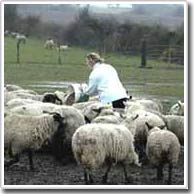Movement strategy of a collective
What is the difference between a group of people and a flock of sheep? There is no big difference between these two ' crowds ', because each group will always be run by a few ' individuals ' in that group.
People in a group do not seem to be much different from flocks or migratory birds. Scientists at the University of Leeds have affirmed that after performing a series of unique experiments to decipher the mysteries around the river. According to them, a small number of about 5% of individuals in the herd have the ability to ' orient ' the whole herd and the remaining 95% follow without any complaints.
 To come to this conclusion, scientists released hamsters in a large room. In the herd, some individuals require the whole herd to start moving. Scientists found that after a while all of the subjects were re-organized and followed the words of those " leader " mice. Meanwhile there is not any ' communication ' between them. In most cases, respondents were often unaware of their instruction.
To come to this conclusion, scientists released hamsters in a large room. In the herd, some individuals require the whole herd to start moving. Scientists found that after a while all of the subjects were re-organized and followed the words of those " leader " mice. Meanwhile there is not any ' communication ' between them. In most cases, respondents were often unaware of their instruction.
A number of other experiments were also conducted with many herds of individuals and the proportion of individuals with different leadership abilities. Experiments prove that the larger the number of individuals in the herd, the less need an engine to launch self-organization in the herd. Just as in the collective of 200 or more people, only 5% of people who grasp the situation are able to control the whole group . Scientists also focused on studying the position of leadership mice in different situations to determine whether these mice moved to cause the herd to follow.
A detailed report was published in Animal Behavior . The finding could serve to predict the behavior of populations while developing rapid "evacuation" strategies for the population in the face of natural " mother " disasters in the future. .
- From chaos to order: How to find food?
- The mystery of the collective suicide of animals
- Why do whales 'commit suicide' series?
- The most terrible collective suicides in history
- Southeast Asia should learn Chinese technology strategy
- Why are ants so crowded, but their whole nest never gets in traffic?
- Finding collective children graves dating back about 550 years
- 'Haunted' disease in Malaysian school
- Learn about collective separation disorder
- Biofuels: An appropriate strategy?
- The UN proposed a 7-point strategy
- Animal suicide - the mystery of 'conscious death'
 'Fine laughs' - Scary and painful torture in ancient times
'Fine laughs' - Scary and painful torture in ancient times The sequence of numbers 142857 of the Egyptian pyramids is known as the strangest number in the world - Why?
The sequence of numbers 142857 of the Egyptian pyramids is known as the strangest number in the world - Why? History of the iron
History of the iron What is alum?
What is alum?